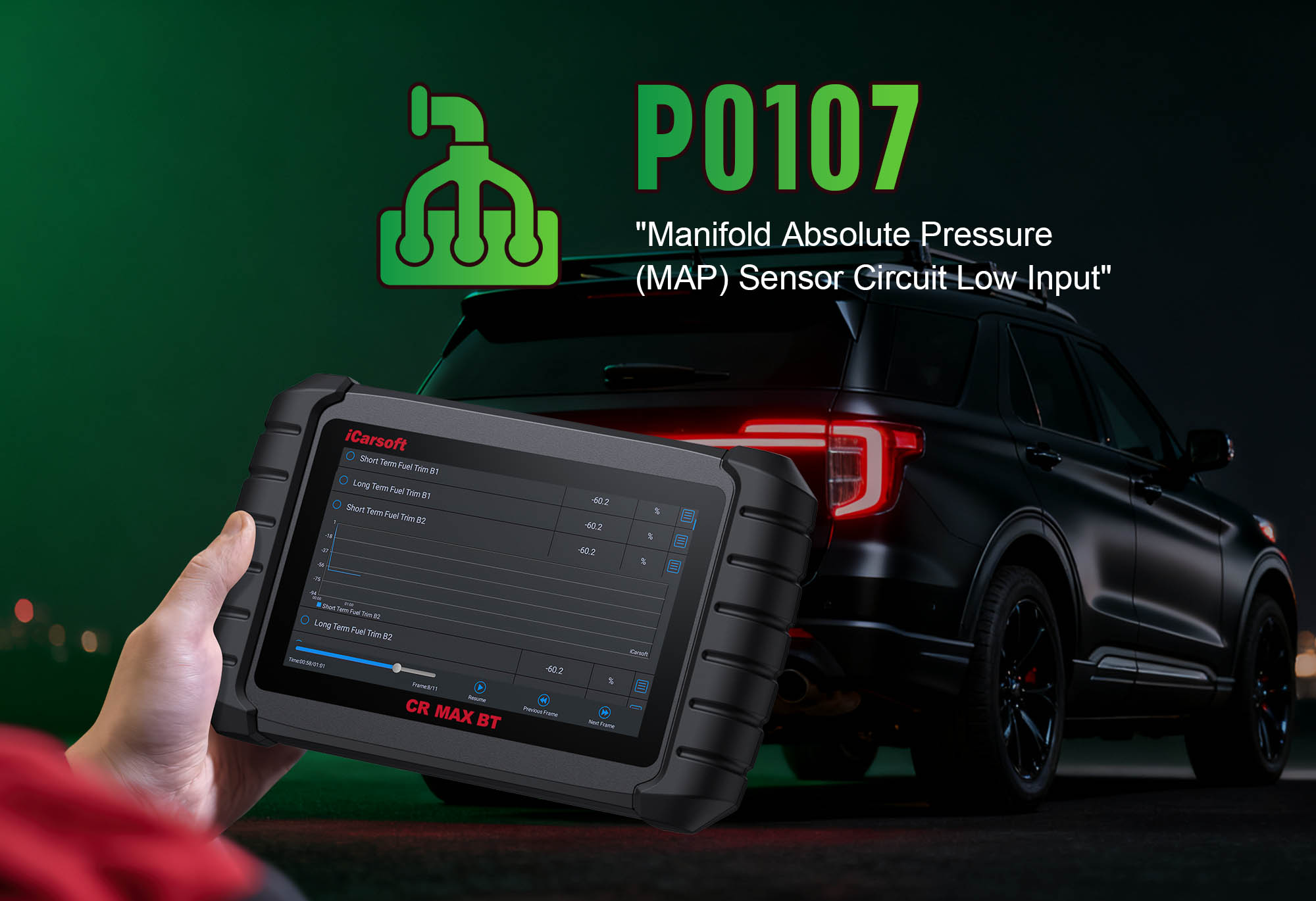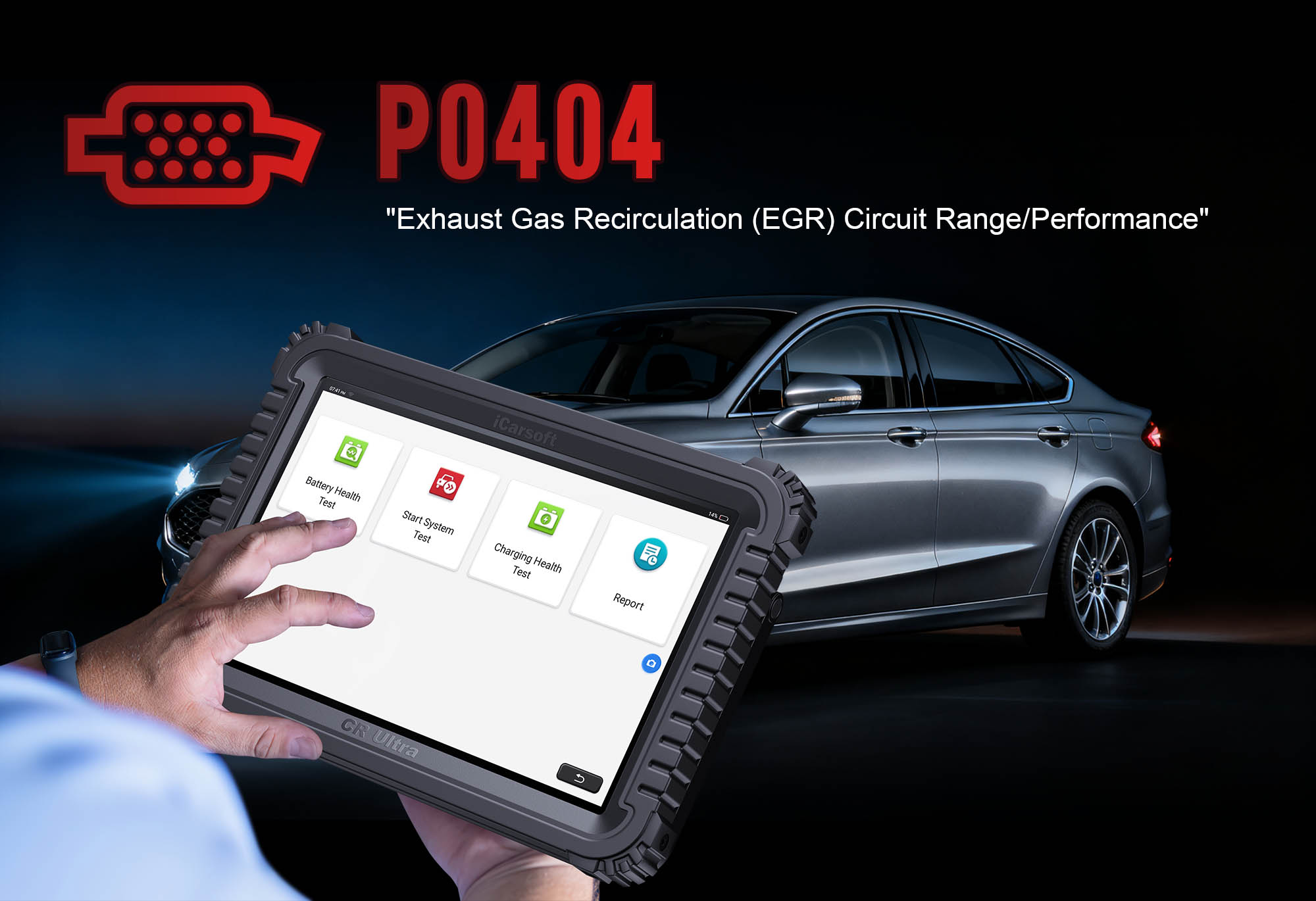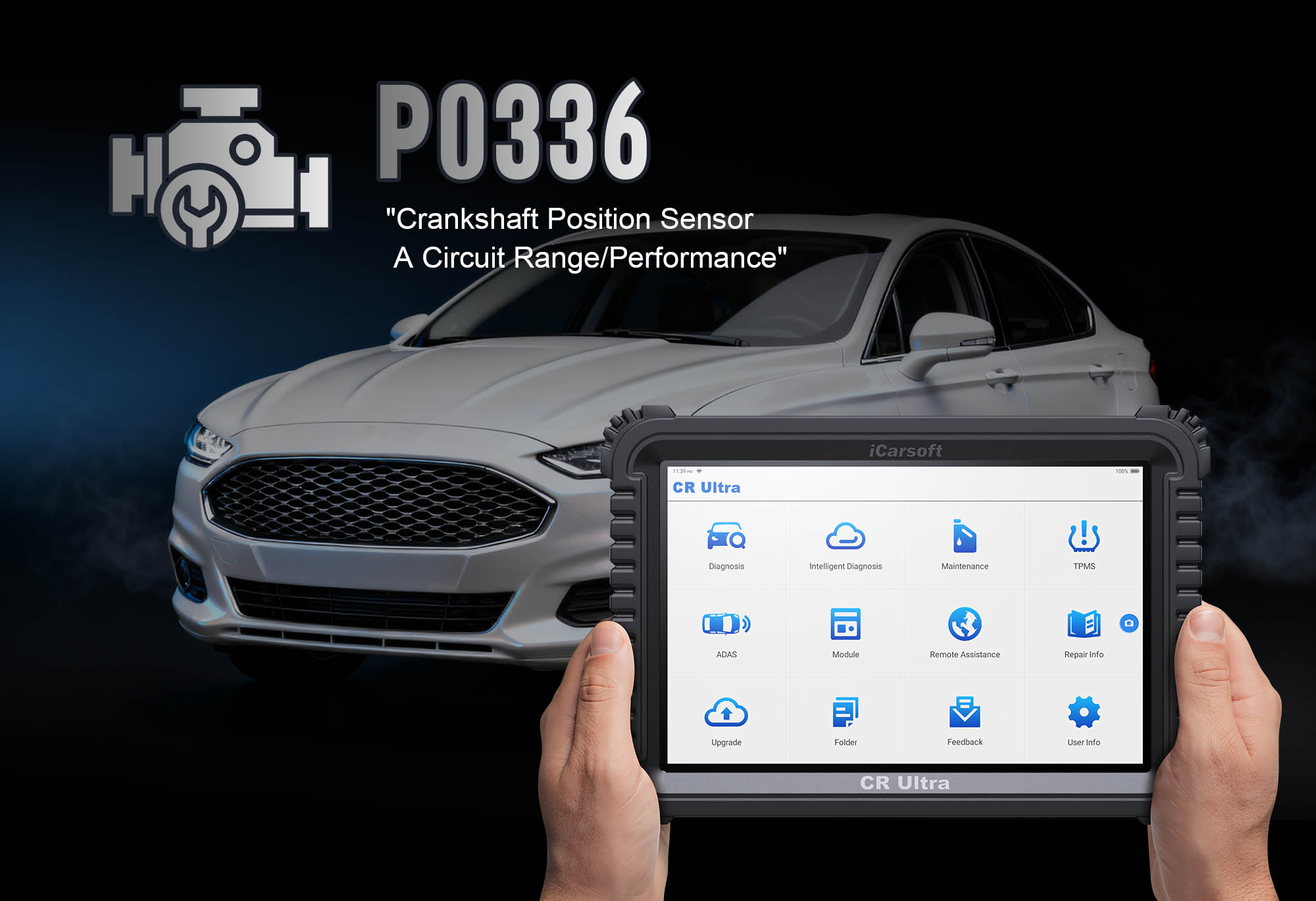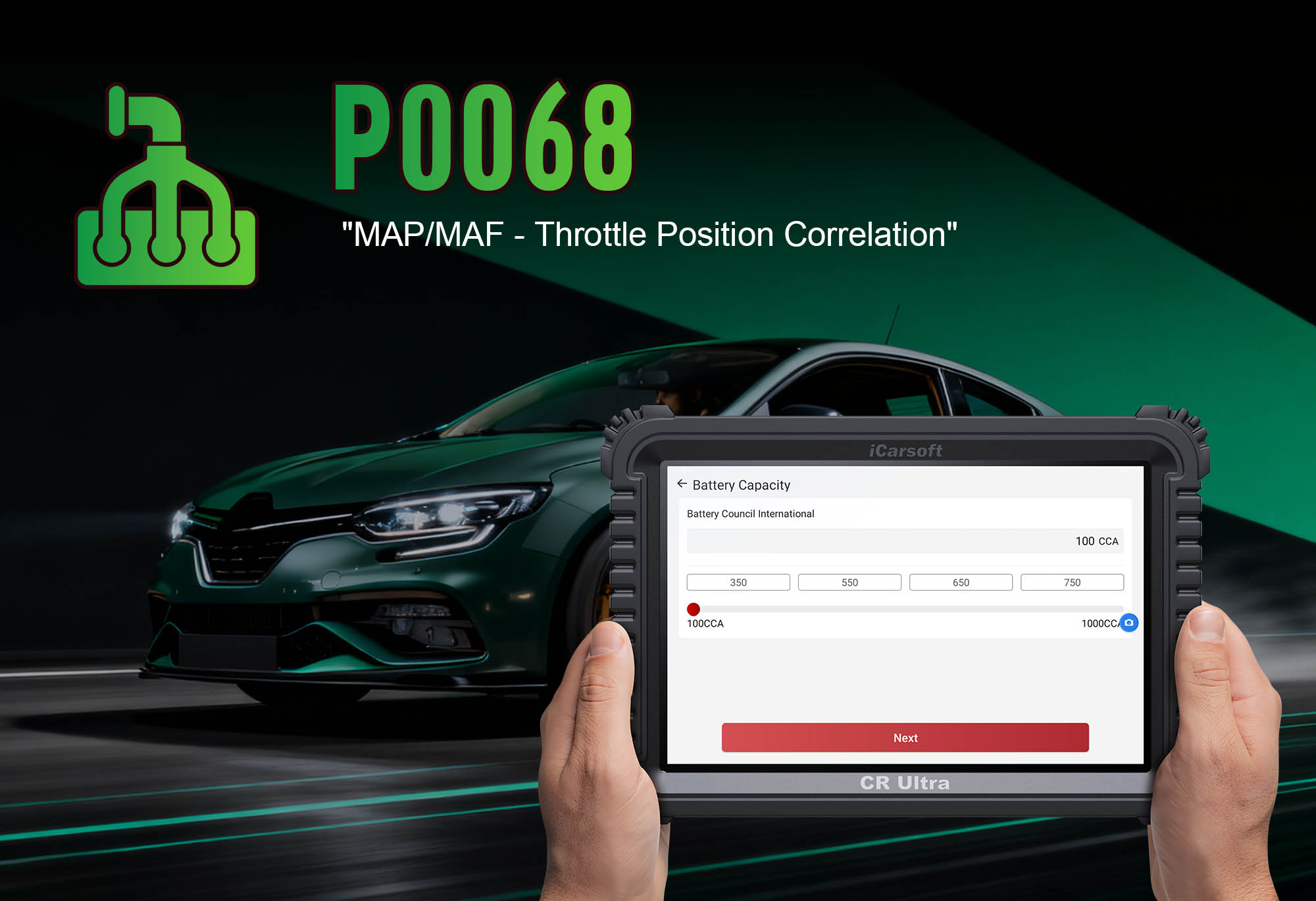Diagnose & Clear P0107 with iCarsoft CR MAX BT: Fix Manifold Absolute Pressure (MAP) Sensor Circuit Low Input
If your check engine light illuminates and you notice rough idling, hesitation during acceleration, or even stalling, a diagnostic scan will likely return P0107. This OBD-II code stands for "Manifold Absolute Pressure (MAP) Sensor Circuit Low Input," indicating the Engine Control Module (ECM) has detected an abnormally low voltage signal from the MAP sensor—typically below 0.5V when the engine is running.
The MAP sensor monitors intake manifold pressure, which the ECM uses to calculate air density and adjust fuel injection, ignition timing, and turbocharger boost (in forced-induction engines). At idle, manifold pressure is low (high vacuum), producing a low sensor voltage (~0.9–1.5V); under load, pressure rises, increasing voltage (~4.0–4.5V). When P0107 occurs, the sensor sends a voltage too low for the current engine conditions, disrupting the air-fuel mixture and engine performance.
Basic scanners may only flag "MAP sensor low" but can’t test voltage patterns or isolate circuit faults. The iCarsoft CR MAX BT—with its live voltage tracking, sensor simulation, and circuit integrity tests—solves this. Let’s explore how to diagnose and resolve P0107 using this advanced tool.
 iCarsoft CR MAX BT: Monitoring MAP sensor voltage to diagnose P0107 low input
iCarsoft CR MAX BT: Monitoring MAP sensor voltage to diagnose P0107 low input
Understanding P0107: Causes & Key Symptoms
A low-input MAP sensor signal disrupts the ECM’s ability to calculate air density, leading to distinct performance issues:
Key Symptoms of P0107
-
Check Engine Light: Illuminates when the MAP sensor voltage remains below 0.5V (or manufacturer-specific threshold) for 2+ drive cycles.
-
Rough Idle or Stalling: A falsely low pressure reading tricks the ECM into reducing fuel delivery, causing unstable idle or stalling at stops.
-
Hesitation or Power Loss: During acceleration, insufficient fuel (due to low MAP signal) leads to delayed response or reduced power.
-
Increased Fuel Consumption: The ECM may overcompensate for the low signal with a richer mixture, lowering MPG by 10–15%.
-
Turbocharger Issues (If Equipped): A faulty MAP sensor can prevent proper boost control, causing underboost or overboost conditions.
-
Cold Start Difficulties: Incorrect air-fuel mixture makes cold starts harder, with extended cranking or rough running initially.
Common Causes of P0107
-
Faulty MAP Sensor: Internal electrical failure (e.g., a damaged pressure transducer) causes the sensor to output a persistently low voltage.
-
Vacuum Leaks: Unmetered air entering the intake manifold (via cracked hoses, loose gaskets, or a faulty PCV valve) creates excessive vacuum, lowering manifold pressure.
-
Damaged Wiring or Connector: Frayed wires, corroded terminals, or loose plugs in the MAP sensor circuit create high resistance, dropping voltage.
-
Clogged MAP Sensor Port: Carbon buildup or debris blocks the sensor’s vacuum port, preventing it from detecting actual manifold pressure.
-
ECM Malfunction (Rare): A faulty ECM may incorrectly interpret sensor data or fail to supply proper reference voltage (5V) to the sensor.
-
Failed Voltage Regulator: A damaged regulator reduces the 5V reference voltage to the sensor, causing low input readings.
Why iCarsoft CR MAX BT Excels at Diagnosing P0107
The CR MAX BT outperforms basic tools with features tailored to MAP sensor diagnostics:
Live Voltage & Pressure Tracking
Monitors real-time MAP sensor voltage and calculated manifold pressure, highlighting abnormal patterns (e.g., "Voltage = 0.3V at WOT—should be 4.2V").
Sensor Simulation
Sends a simulated voltage signal to the ECM to verify if the issue lies with the sensor or the ECM/circuit.
3D Component Diagrams
Preloaded schematics show the MAP sensor location (usually on the intake manifold or throttle body) and wiring paths for 80+ makes (e.g., GM, Ford, Honda, Volkswagen).
Circuit Integrity Tests
Measures resistance, continuity, and reference voltage in the MAP sensor circuit to identify shorts, opens, or corrosion.
Vacuum Leak Detection
Correlates MAP readings with engine load to flag potential leaks (e.g., "Pressure remains low during acceleration—consistent with vacuum leak").
Freeze Frame Analysis
Captures conditions when P0107 was triggered (e.g., "RPM: 800, Load: 20%, Voltage: 0.2V") to contextualize the fault.
Step-by-Step: Diagnose P0107 with iCarsoft CR MAX BT
-
Connect & Confirm the Code
Plug the CR MAX BT into your vehicle’s OBD-II port and pair it with your smartphone/tablet via the iCarsoft app (Bluetooth setup takes 30 seconds). Select your vehicle using Auto VIN Scan (reads VIN instantly) or manual entry (make/model/year/engine). Navigate to Engine > Fault Codes > Read Codes to confirm P0107. Tap Code Details for vehicle-specific insights (e.g., "GM: MAP Sensor Voltage = 0.2V – Below 0.5V Threshold; Check Vacuum Lines").
-
Locate the MAP Sensor
Use the CR MAX BT to avoid confusion:
-
Go to Component Location > Engine > Intake System > MAP Sensor.
-
The app displays a 3D diagram: The MAP sensor is typically a small, rectangular sensor mounted on the intake manifold, throttle body, or firewall, with a vacuum hose and electrical connector.
-
Analyze Live MAP Sensor Data
Real-time data reveals the nature of the low-input issue:
-
Start the engine and let it idle for 5 minutes.
-
In the app, go to Engine > Live Data > Intake System and monitor:
-
MAP Sensor Voltage: Normal idle = 0.9–1.5V; P0107 = <0.5V.
-
Calculated Manifold Pressure: Normal idle = 10–15 psi (high vacuum); low readings here confirm the sensor’s low voltage is not a false signal.
-
5V Reference Voltage: Should remain steady at 4.5–5.5V. A drop below 4.5V indicates a faulty ECM or voltage regulator.
-
Rev the engine to 2000 RPM: Voltage should rise to 2.0–3.0V. No increase = sensor or circuit fault.
-
Test for Vacuum Leaks
Vacuum leaks are a top cause of P0107—diagnose with the CR MAX BT:
-
Navigate to Special Functions > Engine > Vacuum Test > Intake Manifold.
-
The app guides you through a leak test:
-
Monitor MAP pressure during idle—steady fluctuations or abnormally low readings (e.g., <8 psi) indicate leaks.
-
Use the app’s Vacuum Leak Location Guide to inspect common points: intake hoses, throttle body gasket, PCV valve, and brake booster hose.
-
Inspect the MAP Sensor & Connector
Physical issues often cause low voltage—check with guidance from the CR MAX BT:
-
Sensor Inspection: Ensure the engine is off. Disconnect the MAP sensor connector and remove the sensor (if accessible). Check for:
-
A clogged vacuum port (clean with compressed air or carb cleaner).
-
Physical damage (cracks in the sensor housing).
-
Oil contamination (sign of a blown turbo seal or PCV system failure).
-
Connector Check: Examine the sensor plug for corrosion (white/green deposits), bent pins, or water intrusion. Clean terminals with electrical contact cleaner.
-
Test the MAP Sensor Circuit
Electrical faults disrupt voltage flow—verify with the CR MAX BT:
-
Reference Voltage Test: Turn the ignition to "On" (engine off). Use the app’s Multimeter Function to measure voltage at the sensor’s 5V reference pin (via the connector). <4.5V = ECM or wiring issue.
-
Ground Circuit Test: Measure resistance between the sensor’s ground pin and the vehicle chassis. Normal = <1 ohm. High resistance = corroded ground—clean or repair.
-
Signal Wire Continuity Test: Check continuity between the sensor’s signal pin and the ECM (use the app’s wiring diagram). >1 ohm = broken wire—repair with heat-shrink connectors.
-
Sensor Simulation Test
Rule out ECM issues with the CR MAX BT’s advanced feature:
-
Disconnect the MAP sensor connector.
-
Navigate to Special Functions > Engine > Sensor Simulation > MAP Sensor.
-
The app sends a simulated 1.0V signal (idle condition) to the ECM. If the check engine light turns off temporarily, the original sensor is faulty.
-
Repair & Clear P0107
Fix the Root Cause:
-
Replace the MAP sensor (use OEM for accuracy—check the app’s Part Lookup).
-
Repair vacuum leaks: Replace cracked hoses, tighten loose gaskets, or replace a faulty PCV valve.
-
Clean a clogged sensor port with compressed air or specialized intake cleaner.
-
Repair wiring faults with heat-shrink connectors; replace severely corroded harnesses.
Clear the Code: In the app, go to Engine > Fault Codes > Clear Codes to delete P0107.
-
Validate the Repair
Confirm the MAP sensor and intake system work correctly:
-
Recheck live data—idle voltage should be 0.9–1.5V, rising smoothly with engine load.
-
Test drive for 15–20 minutes, including acceleration and idle, to verify smooth performance.
-
Monitor for stable fuel efficiency and no hesitation during acceleration.
-
Re-scan with the CR MAX BT: No P0107 recurrence = successful repair.
Preventing P0107 Recurrence
The CR MAX BT helps maintain reliable MAP sensor performance long-term:
-
Intake System Maintenance: Use the app’s Service Reminder to inspect vacuum hoses and gaskets every 30,000 miles for cracks or looseness.
-
Sensor Care: Clean the MAP sensor port annually with compressed air to prevent carbon buildup.
-
Electrical Checks: Include the MAP sensor connector in routine inspections—apply dielectric grease to repel moisture.
-
Regular Scans: Use the CR MAX BT’s Quick Scan quarterly to monitor MAP voltage and catch early low-input issues.
Conclusion
P0107’s low MAP sensor input disrupts critical air-fuel calculations, but the iCarsoft CR MAX BT simplifies diagnosis with live voltage tracking, vacuum leak detection, and circuit testing. Whether replacing a sensor, fixing leaks, or repairing wiring, this tool ensures you resolve the root cause—restoring engine performance, fuel efficiency, and reliability.
With the CR MAX BT, tackling "MAP sensor low input" faults becomes a precise process, keeping your engine’s air-fuel mixture perfectly balanced for every driving condition.

 iCarsoft CR MAX BT: Monitoring MAP sensor voltage to diagnose P0107 low input
iCarsoft CR MAX BT: Monitoring MAP sensor voltage to diagnose P0107 low input



